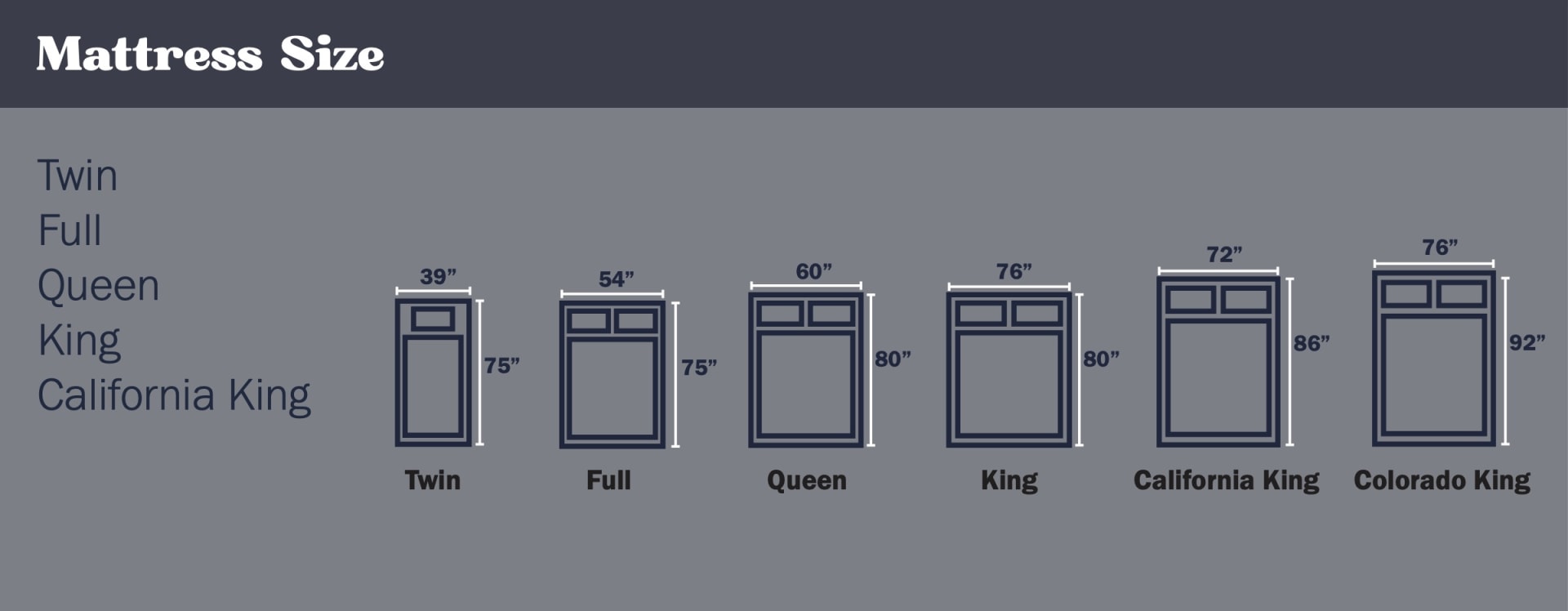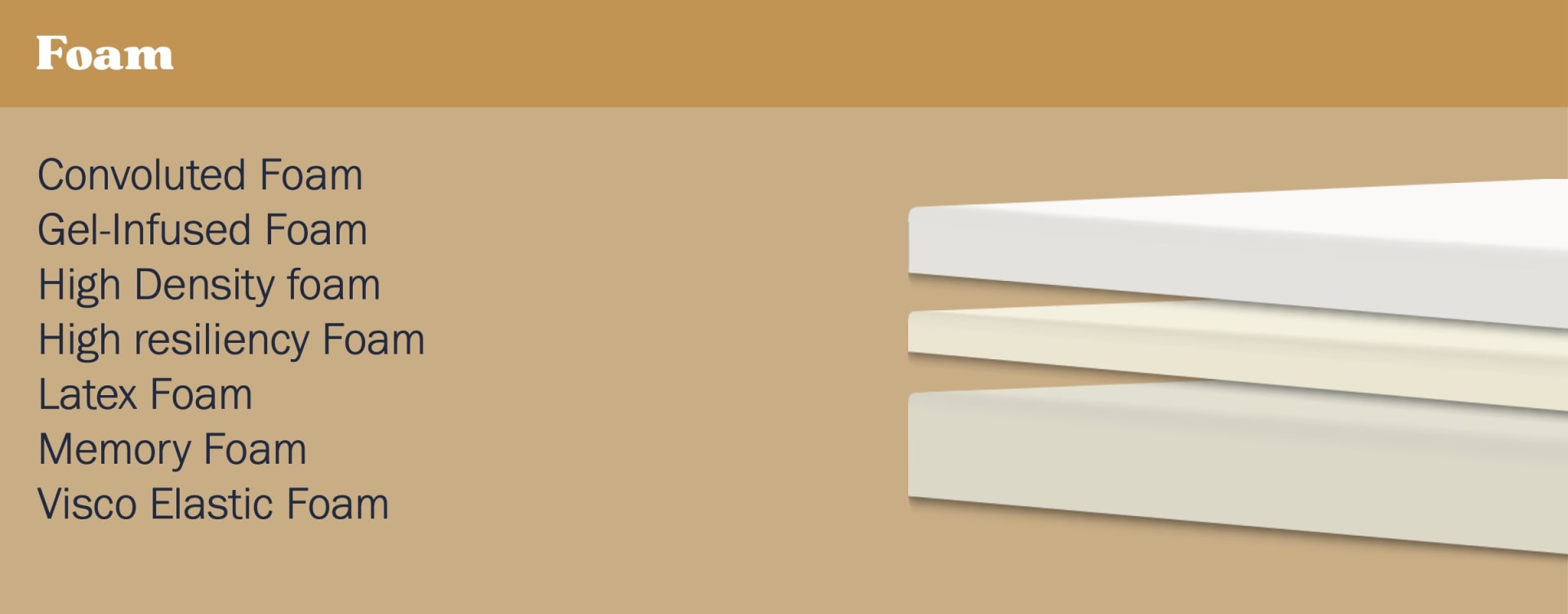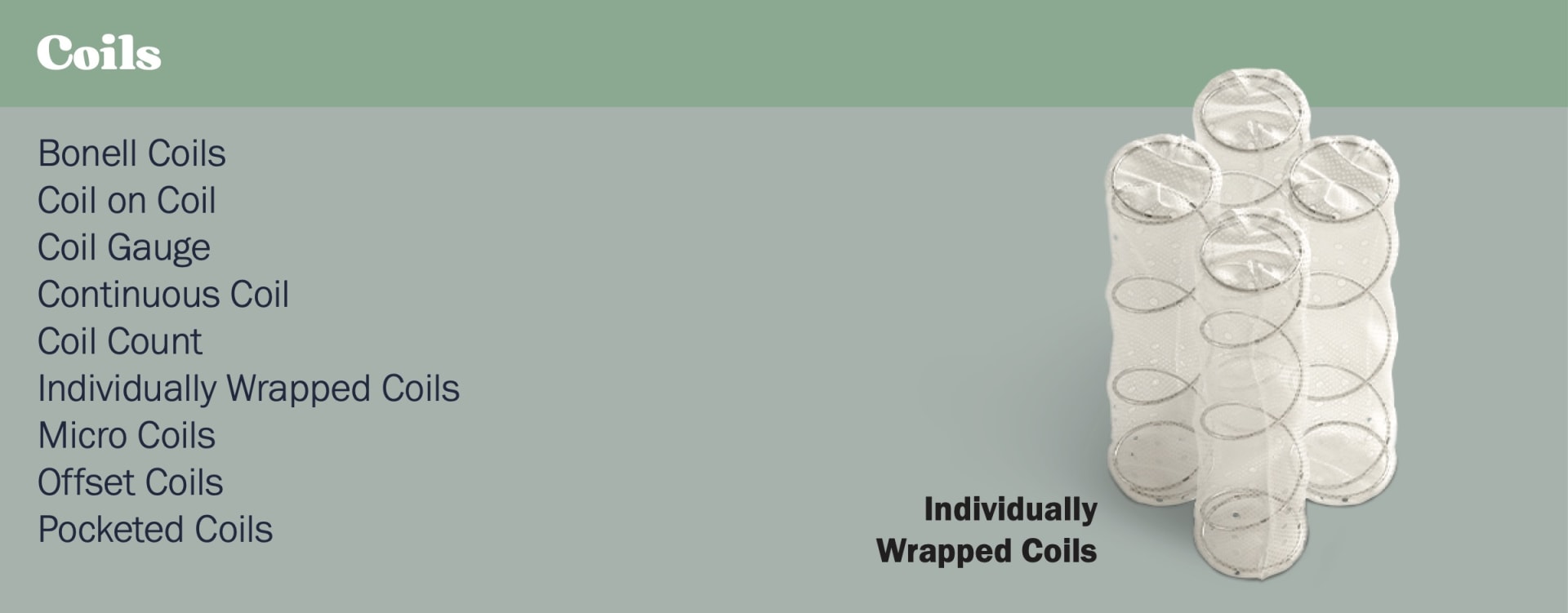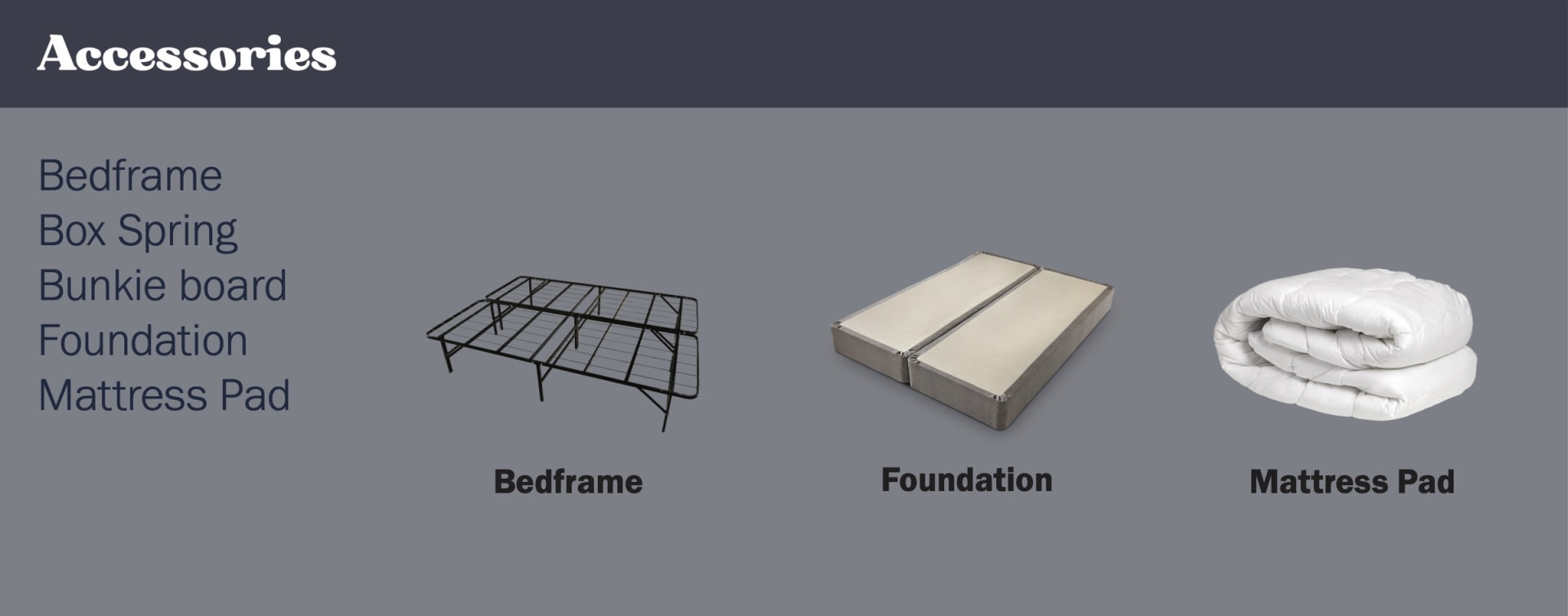Glossary of Common Mattress Terms
At Furniture Row and Denver Mattress, we understand that most people aren’t experts when it comes to finding the perfect mattress. On top of this, as mattresses have gotten more advanced over the years, there’s been a large number of new mattress-related terms making their way through the industry which can cause even more confusion. Whether it’s furniture or mattresses, we pride ourselves on providing our customers with all of the information they need to make a well-informed decision when considering our products. Below is a glossary of commonly used terms that can help make the mattress buying process easier and more enjoyable for everyone.

Adjustable Bed - An adjustable bed is one whose base can be bent or elevated, similar to a hospital bed. These beds are most often used by those who suffer from acid reflux, heartburn, snoring, sleep apnea, or other medical issues that are exacerbated by sleeping horizontally, and they are also great for lounging in bed, reading, and watching TV.
Bed-in-a-Box -The term Bed-in-a-Box refers to the packaging and shipping capabilities of certain types of mattresses. Bed-in-a-Box mattresses are able to be compressed, rolled, and packed into a shipping box that is only a fraction of the original mattress size, making this type of mattress packaging prized for its convenient shipping and delivery. Bed-in-a-Box packaging does not damage the mattress and is most often available for foam mattresses.
Euro Top - A Euro Top mattress is one which features an extra layer of cushioning just below the cover. Unlike a pillow top, a Euro Top is sewn to the top of the mattress which gives it a more streamlined look.
Hybrid Mattress - A Hybrid Mattress is a cross between an innerspring mattress and a foam mattress. Hybrid Mattresses combine the unique strengths of each mattress type by placing layers of comforting memory foam atop durable innerspring coil units.
Innerspring Mattress - The most common type of mattress, an Innerspring Mattress is a mattress that uses a series of metal coils, or “springs”, as a support system. The coils in an Innerspring mattress are encased by layers of cushioning and upholstery, and they come in a variety of configurations such as Bonnell, Offset, Continuous, or Individually-Wrapped. Because they feature metal support systems, Innerspring Mattresses are prized for their exceptional durability.
Pillow Top - A Pillow Top mattress is one which features an extra layer of cushioning on the surface of the mattress. This layer is loosely attached to the top of the mattress and can be made of a variety of materials. Pillow Top mattresses are designed for those who like a luxuriously-soft sleeping surface, though they can still have robust support systems underneath.
Plush- Plush is a commonly used term to describe the comfort level of a mattress. Excellent for side sleepers, plush mattresses are soft and comfortable at the surface, though they can still offer robust internal support systems.

Border Wire - Also called a border rod or border support system, a Border Wire is a sturdy metal wire that runs around the perimeter of a mattress that’s designed to help the mattress keep its shape overtime while also providing edge support for sturdy seating. Border wires are almost always found on innerspring mattresses.
Coils - Coils are the supportive metal springs found in innerspring and hybrid mattresses. Designed to work together in a system, coils can come in a variety of shapes, sizes, and configurations.
Comfort Layer - The Comfort Layer of a mattress refers to the layers of foam or other cushioning which rest atop the mattress’s internal support structure which is usually the coil unit or high-density foam layer in all-foam mattresses. The comfort layer determines how soft or firm a mattress feels to the touch.
Core - See Support Layer
Cover - The Cover, sometimes called “ticking”, is the fabric exterior of a mattress. The Cover encases all of the layers of a mattress, holding them all in place.
Foam - Foam is a common material found in most mattresses which is prized for its combination of durability, comfort, and support. Mattress Foam is typically made from polyurethane or latex, and it can offer a variety of different comfort levels depending on its density.
Foam Encasement- Foam Encasement refers to a system of foam rails placed around the outside edges of a mattress. Foam Encasement surrounds the mattress’s internal support layers, helping it maintain its shape as well as a level sleeping surface.
Polyurethane- Polyurethane is a well-used mattress construction material, most commonly seen in the comfort layers of mattresses as Polyurethane foam (sometimes called “Polyfoam”) or Visco-elastic Polyurethane foam (sometimes called “Memory Foam”). Polyurethane foam is available in a variety of different grades, and high-density Polyurethane foam can even be used in a mattress’s support layer or core.
Quilt- The term Quilt refers to the top of the comfort layer and is usually made up of foam or fibers beneath the mattress cover. This layer provides extra comfort and can include a pillow top or a Euro Top. Quilting can also refer to the stitching design of the cover or other padding layers.
Support Layer - The Support Layer, sometimes called the Core, is the internal support structure in a mattress that’s designed to support body weight. The Support Layer of an innerspring mattress is its coil unit whereas the Support Layer of a foam mattress is usually a layer of high-density foam that’s sturdier and more stable than the foam layers closer to the surface.

Twin Size - Twin Size refers to a certain size of mattress measuring 38" x 75". Twin size mattresses are the smallest mattresses in standard sizes and are often referred to as “singles”.
Full Size - Full Size refers to a certain size of mattress measuring 54" x 75". A Full Size mattress is also called a “double”.
Queen Size - Queen Size refers to a certain size of mattress measuring 60" x 80".
King Size - King Size refers to a certain size of mattress measuring 76" x 80".
California King- California King is a term for the size of a mattress measuring 72" x 84". California Kings are longer and narrower than traditional king size mattresses with about the same surface area.
Colorado King- Colorado King Size refers to a certain size of mattress measuring 76" x 92".

Air Flow - Air flow is a measure of how much air can flow through certain mattress construction materials such as foam and upholstery. Air Flow prevents mattresses from trapping heat which leads to a cooler sleep experience.
Alignment- Alignment refers to the positioning of the body. Mattresses that help promote “healthy spinal alignment” are those which are designed to help the spine maintain a healthy “S” shape while you sleep.
Knit Fabric- In Mattresses, Knit Fabric is a type of cover fabric which is knitted instead of woven like traditional mattress covers. Knit Fabrics are popular because they are often softer and stretchier than other fabrics.
Motion Separation - Motion Separation, also called Motion Transfer, is a term used to describe how well or poorly a mattress transfers motion between sleeping partners. A mattress with exceptional Motion Separation is one where the movements of someone on one side of the bed are not felt by the person on the opposite side.
Posturized- Posturized is a term used to describe a mattress or foundation that has been constructed with additional support in the center in order to prevent sagging over time.
Pressure Points - Pressure Points are the parts of the body that receive the most body weight when lying down. If left unsupported, the pressure in these areas restricts blood during sleep which can cause pain, discomfort, and numbness, resulting in a poor night’s sleep.
Zoned Support - Zoned Support refers to mattresses that are constructed with differing levels of support for different parts of the body. Most mattresses with zoned support offer two or three distinct “zones” with varying firmness to best support different parts of the body such as the hips, torso, and legs. Zoned support mattresses can be designed to maximize comfort or to promote healthy sleeping posture.

Convoluted Foam - Convoluted Foam, sometimes called egg crate foam, is a common foam configuration which features peaks and valleys. Convoluted Foam offers deep compression support, and it is cooler and more breathable compared to uniform foams.
Density - When referring to mattress foam, Density is the foam’s weight per cubic foot. Because the internal qualities of foams can vary greatly, Density does not necessarily affect how firm or soft a foam is, instead it determines the foam’s quality and durability. Higher density foams are usually more durable while lighter density foams are usually less durable.
Gel-infused Foam - Gel-infused Foam is usually a memory foam which contains beads of cooling gel. The gel is used to help maintain comfortable body temperature as it absorbs excess body heat and dissipates it throughout the rest of the mattress.
High-Density Foam - High-Density Foam is a type of foam with a high weight per cubic foot. High-Density Foams have strong cell structures which makes them highly-durable, though it should be noted that a foam’s density is primarily an indicator of its durability rather than its softness or firmness.
High-Resiliency Foam - High-Resiliency Foam is a high-grade open cell foam which offers superior resilience, comfort, and durability. These foams have a unique, elastic cell structure which “bounces back” from pressure exceptionally well, and they usually have a density of 2.5lbs to 2.8lbs.
Latex Foam - Latex Foam is a type of mattress foam which is made from either natural or rubber sap or synthetic liquids. Latex Foam is available in a variety of firmness levels, and it’s known for its exceptional responsiveness and resilience as well as its antimicrobial and cooling properties. Latex Foam is available in a variety of firmness levels, and it can be formed under a variety of processes, the most common of which are Talalay and Dunlop. The Dunlop process is generally simpler and produces a firmer, less expensive material while the Talalay process is more complex and produces a softer, less-dense material.
Memory Foam - A commonly used mattress material, Memory Foam is a Visco-elastic polyurethane foam which offers exceptional support as well as contouring comfort. Memory Foam mattresses typically offer superior support, pressure relief, and motion separation capabilities when compared to traditional foam mattresses, but they also absorb more heat unless paired with some kind of cooling technology.
Visco-elastic Foam - Visco-elastic Foam, sometimes just called “visco, is another name for memory foam.

Bonnell Coils - Bonnell Coils, also called open coils, are some of the first types of innerspring mattress coils. These coils have an hourglass shape, they are connected to each other by small helical coils in a coil unit.
Coil-on-coil - Coil-on-coil is a particular type of coil support system found in some innerspring mattresses. This support system features two layers of coils with one layer placed on top of the other. The top coil layer is often a comfort layer with a higher number of coils while the bottom layer typically is a support layer with a lower number of coils.
Coil Gauge - Coil Gauge refers to the thickness of the coil wire itself. The lower the gauge number, the thicker the coil which results in firmer support. The coils in mattresses usually have a gauge between 12.5 and 17. If you prefer a mattress with more give, then look for a coil gauge of 14 or higher. If you’re after firmer support, then shoot for a coil gauge of 13 or lower.
Continuous Coil - Continuous Coil is a type of coil system found in innerspring mattresses. Continuous coil systems use one long wire to create rows and rows of coils. Because each coil is attached to its neighbors, continuous coil systems are highly-durable and stable, though they do little to mitigate transfer of motion between sleeping partners.
Coil Count - Coil count refers to the number of individual coils in a mattress. Coil counts are always based on the dimensions of the queen size version of a mattress, unless otherwise noted.
Individually-Wrapped Coils - Individually-Wrapped Coils are innerspring mattress coils which are placed inside their own individual fabric “pockets” rather than being connected to any of the other surrounding coils. This coil system offers superior motion separation as well as an enhanced ability to conform to the contours of the body compared to other innerspring coil systems because each coil is able to flex on its own rather than flexing as part of a conjoined unit.
*Individually-Wrapped coils are also referred to as Independent Coils or Pocketed Coils, although The term “Pocketed Coils” is a trademark of the Simmons Bedding Company and refers to their exclusive and proprietary design whereas the term Individually Wrapped is used by other mattress companies to describe a similar system.
Microcoils - Microcoils are coils found in innerspring and hybrid mattresses which are smaller and lighter than traditional coils. Typically ranging anywhere from 1” to 2.5” tall, Microcoils can be found in either the comfort layer or support layer of certain mattresses, and they are prized for their ability to conform to the contours of the body, their superior motion separation, and because they cool more efficiently than traditional coils.
Offset Coils- Offset Coils, or Karr Coils, are a particular coil design that are usually found in more-expensive innerspring mattresses. Offset Coils have the same hourglass shape as Bonnell Coils, though the ends of Offset Coils are squared and connected to the ends of two other coils by helical wires. This slight difference allows each coil to respond to pressure individually, making the coil unit much more flexible and resistant to motion transfer.
Pocketed Coils - See Individually-Wrapped Coils.

Bed Frame - The bed frame is the structure of the bed which supports the mattress and mattress foundation. Almost always made of metal or wood, a bed frame includes the bed’s side rails, headboard, and footboard. For heavy duty or larger beds, the bed frame also includes the center support rail.
Box Spring - Separate from the mattress itself, box springs are mattress-sized support units which are meant to be placed beneath the mattress. Box springs are relatively lightweight, and they typically feature a wood frame with metal support rods or coils. Box Springs can sometimes be referred to as a mattress’s “foundation”.
Bunkie Board - A Bunkie Board or Bunky Board is a thin mattress-sized platform that is designed to be placed under a mattress for added support. Bunkie Boards are primarily used on bunk beds or other beds where a mattress would rest atop wooden slats, but they are also used for certain types of platform beds. Bunkie Boards are most effective in extending the life of foam mattresses as they are the most likely to wear unevenly when placed atop slats or other non-flat surfaces.
Foundation - See Box Spring.
Mattress Pad - A Mattress Pad, or Mattress Topper, is a layer of cushioning separate from the mattress itself which is designed to lie on top of a mattress. These pads can be made from a variety of materials such as foam or feathers, and they are often used to add an extra layer of comfort to a mattress that would otherwise be too firm for the user.

Hypoallergenic- A material is deemed Hypoallergenic if it does not provoke an allergic reaction. Hypoallergenic materials cannot guarantee that they are 100% allergen-free, but the risk of an allergic reaction is much less likely than in other products.
Lumbar - Lumbar is a commonly used term in the mattress industry referring to the lower back. The Lumbar region is located between the bottom ribs and the hip bones, and it can be the source of discomfort and pain if not kept in alignment.
Off Gassing - Off Gassing refers to the process of releasing chemicals into the air. In some mattresses, this process can occur once the mattress is taken out of its packaging, with strong odors or potentially harmful chemicals being released into the air for up to seven days. These chemicals, sometimes referred to as volatile organic compounds (VOCs), can include harmful compounds such as benzene, toluene chlorofluorocarbons (CFCs) and formaldehyde. If Off Gassing is known to occur in a mattress, there is usually a label or some other literature which encourages consumers to Off Gas a mattress in a separate room or even outside.
At Denver Mattress, we understand the safety concerns related to Off Gassing. That's why all Denver Mattress® brand mattresses are made using CertiPUR-US® certified polyurethane foams. CertiPUR-US® approved foams are:
- Made without ozone depleters
- Made without PBDEs, TDCPP or TCEP(“Tris”) flame retardants
- Made without mercury, lead, and other heavy metals
- Made without formaldehyde
- Made without phthalates regulated by the Consumer Product Safety Commission
- Low VOC(Volatile Organic Compound) emissions for indoor air quality (less than 0.5 parts per million)
Orthopedic - Orthopedic is a term used for mattresses that provide pressure point-relief and promote a sleeping healthy posture. Orthopedic mattresses can be either firm or soft so long as they provide a certain type of support that’s healthy for the body or that can help alleviate bodily pain.